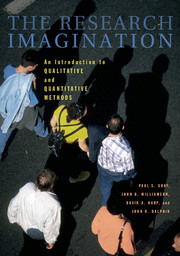Book contents
- Frontmatter
- Contents
- Preface
- 1 RESEARCH PROCESS
- 2 THEORY AND METHOD
- 3 RESEARCH DESIGN
- 4 MEASUREMENT
- 5 ETHICAL AND POLITICAL ISSUES
- 6 SAMPLING
- 7 SURVEY RESEARCH
- 8 INTENSIVE INTERVIEWING
- 9 OBSERVATIONAL FIELD RESEARCH
- 10 FEMINIST METHODS
- 11 HISTORICAL ANALYSIS
- 12 EXPERIMENTAL RESEARCH
- 13 CONTENT ANALYSIS
- 14 AGGREGATE DATA ANALYSIS
- 15 COMPARATIVE RESEARCH METHODS
- 16 EVALUATION RESEARCH
- 17 INDEXES AND SCALES
- 18 BASIC STATISTICAL ANALYSIS
- 19 MULTIVARIATE ANALYSIS AND STATISTICAL SIGNIFICANCE
- EPILOGUE: THE VALUE AND LIMITS OF SOCIAL SCIENCE KNOWLEDGE
- Appendix A A Precoded Questionnaire
- Appendix B Excerpt from a Codebook
- Author Index
- Subject Index
- References
7 - SURVEY RESEARCH
Published online by Cambridge University Press: 05 June 2012
- Frontmatter
- Contents
- Preface
- 1 RESEARCH PROCESS
- 2 THEORY AND METHOD
- 3 RESEARCH DESIGN
- 4 MEASUREMENT
- 5 ETHICAL AND POLITICAL ISSUES
- 6 SAMPLING
- 7 SURVEY RESEARCH
- 8 INTENSIVE INTERVIEWING
- 9 OBSERVATIONAL FIELD RESEARCH
- 10 FEMINIST METHODS
- 11 HISTORICAL ANALYSIS
- 12 EXPERIMENTAL RESEARCH
- 13 CONTENT ANALYSIS
- 14 AGGREGATE DATA ANALYSIS
- 15 COMPARATIVE RESEARCH METHODS
- 16 EVALUATION RESEARCH
- 17 INDEXES AND SCALES
- 18 BASIC STATISTICAL ANALYSIS
- 19 MULTIVARIATE ANALYSIS AND STATISTICAL SIGNIFICANCE
- EPILOGUE: THE VALUE AND LIMITS OF SOCIAL SCIENCE KNOWLEDGE
- Appendix A A Precoded Questionnaire
- Appendix B Excerpt from a Codebook
- Author Index
- Subject Index
- References
Summary
INTRODUCTION
Having learned about sampling in the preceding chapter, we are now ready to examine social surveys, a quantitative technique. Surveys are the most common form of research in the social sciences. We are all regularly exposed to surveys in one form or another. We may be stopped on the street or in a shopping mall by interviewers who ask our opinions on current issues or our preferences for consumer items. We are telephoned by surveyors who ask how we intend to vote in an upcoming election or why we chose one airline over another. We receive a variety of questionnaires in the mail – from government agencies, business corporations, and community organizations. Newspapers report the latest public opinion polls; the major television networks employ their own pollsters. All these are forms of survey research: systematic attempts to collect information, mostly from individuals, to describe and explain the beliefs, attitudes, values, and behavior of selected groups of people. Nearly every topic of interest in the social sciences has been studied through surveys, and the broad adaptability of this research method is one of its greatest strengths.
The characteristic of surveys that best illustrates their value and explains their extensive use is their ability to produce a representative distribution, or cross section, of the “target” population, whether that population is the entire American voting public or the people who stayed at a certain hotel during a given month. So, surveys are most often coupled with probability sampling techniques.
- Type
- Chapter
- Information
- The Research ImaginationAn Introduction to Qualitative and Quantitative Methods, pp. 121 - 150Publisher: Cambridge University PressPrint publication year: 2007

